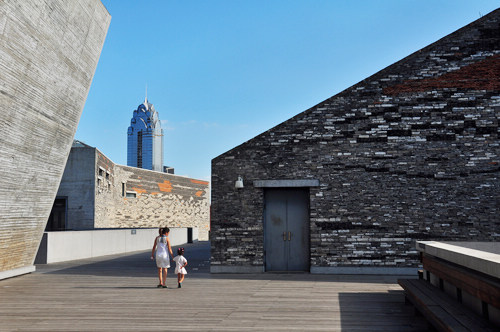|
 |
|
TAKING A STROLL: A mother and her child wander along the walls of Ningbo Museum in Zhejiang Province. The museum is designed by Wang Shu, who uses recycled bricks to build the museum (HU XUEJUN) |
Wang's works show a profound interpretation of modern architecture and a good knowledge of traditions. Through such a balance, he had created a new type of Chinese architecture, said Tadao Ando, a Japanese architect and the winner of the 1995 Pritzker Prize. Ando said Wang's creation should be recognized by the whole world.
Wang believes traditions should not be sealed in glass boxes at museums. "That is only evidence that proves the traditions once existed," he said.
"Many Chinese people have a misunderstanding of traditions. They think tradition means old things from the past. In fact, tradition also refers to the things that have been developing and that are still being established," he said.
"Today, the Chinese people are obsessed with learning Western styles and philosophy rather than focusing on Chinese traditions. Many people tend to talk about traditions without knowing what they really are," said Wang.
The study of traditions should be combined with practice. Otherwise, the recreation of traditions would be artificial and empty, he said.
Originality
Wang said he was grateful that the CAA gave him the opportunity to design its Xiangshan campus. Despite some criticism of his design, Xu Jiang, President of the CAA, supported him firmly.
From 2007 to 2009, Wang led the design of the Imperial Street of Southern Song Dynasty (1127-1279) in Hangzhou.
The old street dated back to the Southern Song Dynasty. However, due to hundreds of years of disrepair, the 4,000-meter-long street, once a thriving marketplace, was almost a ruin.
Exploration on the reconstruction began as early as 2001, but no consensus was reached. Finally, the municipal government invited Wang to take charge of the project.
Wang made his points clear. First of all, the government should give him at least three years for the construction of the project, and before construction, he needed half a year for research. Second, it was essential to keep a strong sense of life in the street. Wang said if all the residents were moved out, leaving only commercial real estate, the street would lose its vigor and vitality. Third, he was opposed to the idea of tearing down the old street and building a new imitative one.
Luckily, the local government accepted these conditions and the municipal officials gave him full support. The project proved another big success.
Wang graduated with a master's degree in 1988. In the next 10 years, he did not start design work like his classmates. Instead, he worked together with the construction workers. He accumulated abundant practical experience and formed a unique style of architectural design. He pursued further study for a Ph.D in 1998.
Wang is known as a very special architect. He is opposed to demolition, he is not into landmark buildings, and seldom takes on commercial projects. In China, which is undergoing rapid urbanization and architectural design industrialization, he is seen as an alien. He has always kept some distance from the trend.
"A good architect should have a special set of ideas that he sticks to. And he should always bring his ideas into practice," said Wang.
Many architects tend to believe the reason they cannot do a good job was because they lack a good idea. "This was wrong," Wang said. "In my opinion, what they lack badly is a coherent and sustained architectural philosophy," he said.
Wang Shu's Representative Works
- 2010: Decay of the Dome at the 12th Venice Architecture Biennale, Venice, Italy
- 2010: Ningbo Tengtou Pavilion at the World Expo 2010, Shanghai
- 2009: Imperial Street of the Southern Song Dynasty (1127-1279), Hangzhou, Zhejiang Province
- 2008: Ningbo Museum, Ningbo, Zhejiang Province
- 2007: The second phase of the Xiangshan campus of the CAA, Hangzhou, Zhejiang Province
- 2005: Ningbo Museum of Art, Ningbo, Zhejiang Province
- 2004: The first phase of the Xiangshan campus of the China Academy of Art (CAA), Hangzhou, Zhejiang Province
Email us at: tangyuankai@bjreview.com | 